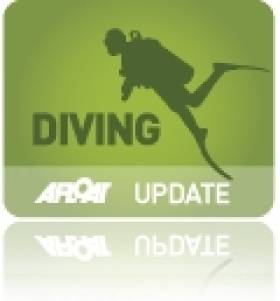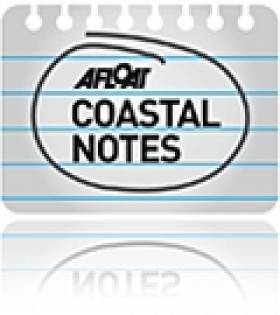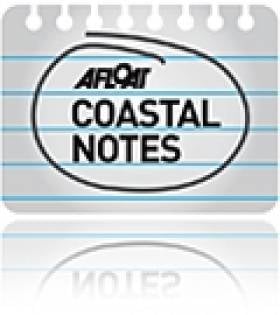Displaying items by tag: shipwreck
Warships, U-boats & Liners – A Guide to Shipwrecks Mapped in Irish Waters
#shipwrecks – In Dublin's Custom House today a stunning new book that showcases some of the more spectacular and important shipwrecks in Irish waters was unveiled. Minister for Arts, Heritage and the Gaeltacht, Jimmy Deenihan, TD together with Fergus O'Dowd TD, Minister of State, Department of Communications, Energy & Natural Resources, officially launched the beautifully illustrated "Warships, U-Boats & Liners - A Guide to Shipwrecks Mapped in Irish Waters."
For the past 12 years Ireland's offshore waters and coastal seas have been subject to one of the largest seabed surveys in the world in a joint venture between the Geological Survey of Ireland (GSI) and the Marine Institute. Photographic and sonar images of over 300 shipwrecks have been compiled during the survey in co-operation with the Department of Arts, Heritage and the Gaeltacht's Underwater Archaeology Unit (UAU), part of the National Monuments Service.
The collaboration between the State Bodies has led to the production of the new book which traces the fascinating history of 60 of the most historic shipwrecks around the Irish coast. The narrative combines archaeology, history and marine mapping and includes never before seen graphic imagery of how these shipwrecks lie on the seafloor today. It also provides in-depth historical background to each ship's construction, history and ultimate fate.
The joint GSI and Marine Institute INFOMAR project, and its predecessor the Irish National Seabed Survey, make up the largest civilian marine mapping programme worldwide and, according to Minister O'Dowd, have "truly made Ireland a leader in this field of endeavour." Over a similar period the UAU has built up an extensive database of shipwrecks (The Shipwreck Inventory of Ireland). "The current database holds over 13,000 wrecks", said Minister Deenihan, "and is an essential management tool for the preservation, protection and promotion of Ireland's rich maritime archaeological heritage."
Minister O'Dowd, commented that "as an island nation we instinctively know that our seas are important, but perhaps we are not fully aware of the scale of this natural resource and heritage they hold". He pointed out that "over 80% of our national territory lies beneath our seas, and that many of the benefits that might be realised for the Country from this resource, are as yet undiscovered."
Minister Deenihan remarked that many of the shipwrecks contained in the book "are important links to major events in our past that need to be monitored to ensure they are protected and preserved." The Minister said that there was "a huge maritime dimension to the shaping of our history in the years leading up to the foundation of the State" and that he was "very much aware of the importance of many of these wrecks to our history."
Pointing out that the publication reflected his Department's commitment to creating an awareness and appreciation of archaeology, Minister Deenihan said that it was also "a showcase of some of the best dive sites in the world which will undoubtedly attract many visitors from near and far"
Both Ministers congratulated the authors, Karl Brady (UAU), Charise McKeon (GSI), James Lyttleton (UCC) and Ian Lawlor (BIM), of this publication and highlighted the book as an excellent example of two different government departments working together in partnership, bringing together expertise in archaeology and marine mapping to highlight Ireland's leading role in seabed mapping and protection and promotion of marine cultural heritage.
Video Shows Divers Exploring Carinthia Wreck Off Donegal
#DIVING - WorldIrish have done it again with another great video find - this time following a team of divers off Donegal as they explore the wreck of the RMS/HMS Carinthia.
On 6 June 1940, during the Second World War, the transatlantic steam-powered cruise liner turned armed merchant ship was sunk by a German U-boat off Tory Island.
The video above shows some of the sights seen by Michael McVeigh and his diving team, including the ship's bow, the anchor telegraph and its wartime addition 6" gun.
Lusitania Owner Rejects TV Doc Findings, Wants Second Dive
#LUSITANIA - The millionaire owner of the Lusitania shipwreck has rejected the findings of the recent TV documentary investigating the mystery of its sinking.
The Irish Independent reports that Gregg Bemis is seeking permission from the Government to mount another dive to the wreck site to "pursue the truth".
On 7 May 1915 the cruise liner RMS Lusitania was hit by a torpedo from a German U-boat off the coast of the Old Head of Kinsale in Co Cork, with the loss of 1,198 lives.
A second explosion was reported minutes later, and within 20 minutes the vessel was underwater. Only 761 people survived.
Last summer Bemis launched what was expected to be the last dive expedition to find out what really happened to the former Cunard passenger liner.
However, Bemis argues that the National Geographic documentary team behind 'Dark Secrets of the Lusitania' used "insufficient data" when they concluded that the second explosion on the vessel following a torpedo strike was from a boiler blowing up in the bowels of the ship.
He remains convinced that a secret cargo of Allied munitions was responsible for the devastating explosion that sealed the ship's fate.
"They did not have all the information they should have had," said Bemis. "They used a computer analysis to get their theory and a computer is only as good as the garbage you put in. You put garbage in, you get garbage out."
The American said only a second dive with complete access to the hull could uncover what he believes really happened - a project he hopes will take place before the Lusitania centenery.
'Ireland's First Coconuts' Found in West Cork Shipwreck
#COASTAL NOTES - A 17th-century merchant vessel recently discovered off West Cork could have carried Ireland's first coconuts, the Irish Examiner reports.
The shipwreck near Schull was discovered embedded in silt 30ft below the surface by workers laying pipes for the town's new waste treatment plant.
A diving exclusion zone has since been established in the area to protect the site from looters and allow marine archaeologists to investigate the wreck undisturbed.
Coconuts found in the wreck indicate that the vessel was returning to Irish waters from the Caribbean.
Experts are hoping to establish the cause of the shipwreck, which may have been due to dashing against rocks in bad weather.
It is also speculated that the ship went down around the same time of the Sack of Baltimore in 1631, when North African pirates from the Barbary Coast attacked the area, kidnapping hundreds of locals.
The Irish Examiner has more on the story HERE.
Shipwreck Contains Largest Ever Silver Haul Found At Sea
A shipwreck off the southwest coast of Ireland has been found to contain the largest ever haul of precious metal at sea.
Some 200 tonnes of silver worth around €172m were discovered in the wreck of the British cargo ship SS Gairsoppa by a US exploration company, BBC News reports.
The UK merchant vessel was sunk by a German U-boat in 1941 as it was trying to reach shelter in Ireland.
Odyssey Marine, the firm responsible for the discovery, says it is now planning for the recovery of its cargo, with work expected to begin in spring next year.
"By finding this shipwreck and telling the story of its loss, we pay tribute to the brave merchant sailors who lost their lives," said the company's chief archaeologist Neil Dobson.
As per the terms of its contract with the UK Department of Transport, Odyssey Marine will get to keep 80% of the silver's value as profit.
The arrangement has been criticised for allegedly being more about "treasure hunting" than marine archaeology.
"Legitimate, professional archaeologists do not engage in the buying, selling, or valuing of artefacts," writes Mark Staniforth at The Conversation.
BBC News has more on the story HERE.


































































